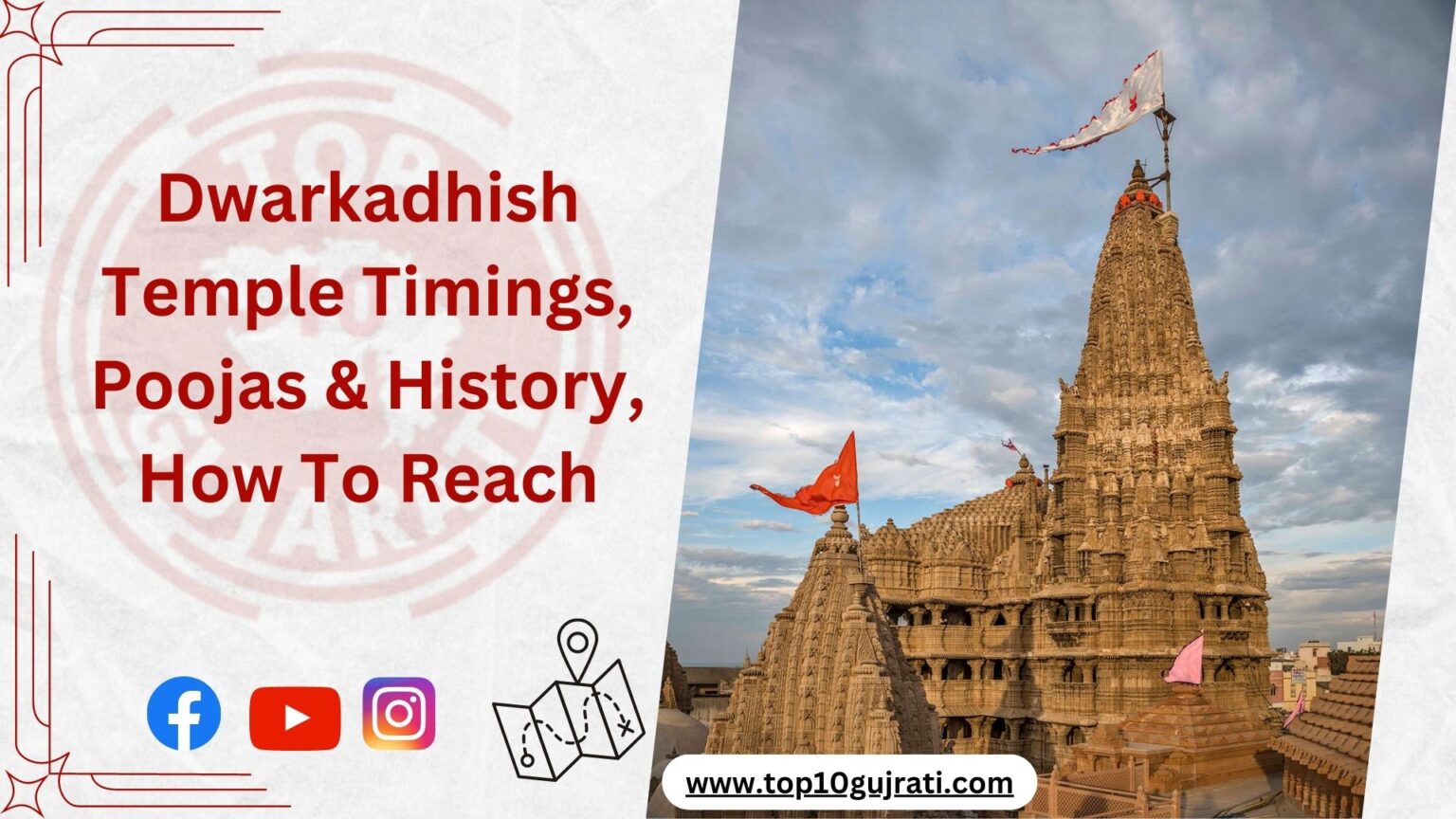Dwarka Temple, also known as Dwarkadhish Temple, is a prominent Hindu temple located in the city of Dwarka in the western state of Gujarat, India. It is one of the four principal sacred pilgrim centers (Char Dham) of Hinduism. The temple is dedicated to Lord Krishna, who is worshipped here as Dwarkadhish, the “King of Dwarka.”
[metaslider id=1725]
Information about Dwarka Temple:
1. Historical Significance: The temple is believed to have been constructed around 2,500 years ago by Vajranabh, the great-grandson of Lord Krishna, on the site where the original city of Dwarka (said to have been submerged under the sea) once stood.
2. Architecture: The Dwarka Temple is a five-storied structure built on a raised platform, and its architecture follows the Chalukya style. The temple is adorned with intricate carvings and sculptures.
3. Sanctum Sanctorum: The main deity inside the temple is a black stone idol of Lord Krishna in a standing posture, often adorned with elaborate decorations and clothing. The sanctum sanctorum is known as the “Garbha Griha.”
4. Festivals: The temple witnesses a grand celebration during Janmashtami, which marks Lord Krishna’s birth anniversary. It attracts a large number of devotees during this festival.
5. Dwarka City: The city of Dwarka itself holds great significance in Hindu mythology and is believed to have been the capital of Lord Krishna’s kingdom.
6. Pilgrimage: Dwarka Temple is one of the most important pilgrimage sites for Hindus and attracts devotees from all over India and abroad.
7. Archaeological Excavations: There have been underwater archaeological excavations near the coast of modern Dwarka, which have revealed ancient structures and artifacts, adding to the historical and religious importance of the region.
Dwarkadhish Temple, also known as Dwarka Temple, is renowned for its unique and intricate architecture, blending different styles that reflect its historical significance and spiritual importance. The temple has undergone several renovations and expansions over the centuries, but its core architectural elements remain impressive. Here are some key features of the temple’s architecture:
1. Chalukyan Style: The main architectural style of the Dwarkadhish Temple is the Chalukyan style, which was prevalent during the 6th to 12th centuries in western India. This style is characterized by intricate carvings, exquisite sculptures, and ornate designs.
2. Five-Storey Structure: The temple is a five-storey structure, with the main shrine dedicated to Lord Krishna located on the highest level. The temple’s height adds to its grandeur and significance as a prominent pilgrimage site.
3. Sandstone Construction: The temple is primarily constructed using sandstone, a common material in traditional Hindu temple architecture in Gujarat and Rajasthan. The sandstone gives the temple a warm and inviting appearance.
4. Main Entrance (North Gate): The main entrance of the temple, known as the North Gate, is an awe-inspiring structure adorned with detailed carvings of elephants and other mythological figures. It is the primary access point for devotees entering the temple complex.
5. Flag Post (Dwajasthamba): Just outside the main entrance, you will find the Dwajasthamba, a tall flag post that symbolizes the temple’s sacredness. It is a common feature in many Hindu temples.
6. Sabha Mandapa: The temple has a spacious and ornate hall known as the Sabha Mandapa or assembly hall. It is used for religious gatherings, rituals, and devotees’ congregations.
7. Garbha Griha: The sanctum sanctorum, known as the Garbha Griha, houses the main deity, Lord Dwarkadhish (Krishna). The idol is black in color and stands in a prominent posture.
8. Sculptures and Carvings: The temple’s exterior and interior are adorned with intricate sculptures and carvings depicting various episodes from Hindu mythology, including scenes from the life of Lord Krishna.
9. Samudra Narayan Temple: Adjacent to the Dwarkadhish Temple, there is another smaller temple called the Samudra Narayan Temple. This temple is dedicated to Lord Vishnu in his form as Samudra Narayan, believed to be the protector of the sea.
The architecture of the Dwarkadhish Temple is a beautiful amalgamation of art, spirituality, and history. It continues to be a significant religious and cultural center, attracting millions of devotees and tourists each year.
The Dwarkadhish Temple in Dwarka, Gujarat, being one of the most important and revered Hindu temples, celebrates several festivals with great enthusiasm and fervor. Some of the major festivals celebrated at the Dwarkadhish Temple are:
1. Janmashtami: Janmashtami is the most significant festival celebrated at the Dwarkadhish Temple. It marks the birth anniversary of Lord Krishna, the presiding deity of the temple. The celebrations last for two days and include various rituals, devotional singing, and cultural performances. The temple is beautifully decorated, and the idol of Lord Krishna is adorned with elaborate decorations and jewelry.
2. Holi: Holi, the festival of colors, is celebrated with joy and enthusiasm at the Dwarkadhish Temple. Devotees and visitors come together to play with colors and celebrate the triumph of good over evil. It is a vibrant and lively celebration.
3. Diwali: Diwali, the festival of lights, is another important festival celebrated at the temple. The entire temple complex is illuminated with thousands of diyas (oil lamps), creating a mesmerizing sight. Devotees offer prayers and seek blessings from Lord Krishna on this auspicious occasion.
4. Navratri: Navratri, a nine-day festival dedicated to the worship of the divine feminine, is celebrated with grandeur at the Dwarkadhish Temple. Devotees participate in Garba and Dandiya Raas dance performances during this festival.
5. Rathyatra: Rathyatra is an annual chariot procession that takes place in Dwarka and other major cities across India. During this festival, the idol of Lord Krishna is placed on a beautifully decorated chariot and pulled by devotees through the streets, symbolizing the journey of the Lord to meet his devotees.
6. Annakut: Annakut is celebrated on the day after Diwali, where a grand display of food offerings is made to Lord Krishna. Devotees prepare a variety of vegetarian dishes and offer them to the deity as a gesture of gratitude and devotion.
Apart from these major festivals, there are also regular daily rituals and aartis performed at the temple. The temple remains a hub of religious activities and attracts a large number of devotees throughout the year.
Time Table
DARSHAN TIMINGS
Morning 6.30 to Afternoon 13.00
and Evening 5.00 to 9.30
| Morning 6.30 | Mangla Arti |
| 7.00 to 8.00 | Mangla Darshan |
| 8.00 to 9.00 | Abhishek Pooja [Snan Vidhi]: Darshan Closed |
| 9.00 to 9.30 | Shringar Darshan |
| 9.30 to 9.45 | Snanbhog : Darshan Closed |
| 9.45 to 10.15 | Shringar Darshan |
| 10.15 to 10.30 | Shringarbhog: Darshan Closed |
| 10.30 to 10.45 | Shringar Arti |
| 11.05 to 11.20 | Gwal Bhog: Darshan Closed |
| 11.20 to 12.00 | Darshan |
| 12.00 to 12.20 | Rajbhog: Darshan Closed |
| 12.20 to 12.30 | Darshan |
| 13.00 | Anosar, Darshan Closed |
Evening Timings:-
| 5.00 Uthappan | First Darshan |
| 5.30 to 5.45 | Uthappan Bhog: Darshan Closed |
| 5.45 to 7.15 | Darshan |
| 7.15 to 7.30 | Sandhya Bhog: Darshan Closed |
| 7.30 to 7.45 | Sandhya Arti |
| 8.00 to 8.10 | Shayanbhog: Darshan Closed |
| 8.10 to 8.30 | Darshan |
| 8.30 to 8.35 | Shayan Arti |
| 8.35 to 9.00 | Darshan |
| 9.00 to 9.20 | Bantabhog and Shayan : Darshan Closed |
| 9.20 to 9.30 | Darshan |
| 9.30 | Darshan Mandir Closed |
Contact Details:
Administrators’ Office
Shree Dwarkadhish Temple Dwarka : 361 335
Dist.: Dev Bhoomi Dwarka
Gujarat- India
STD CODE +91- 2892-234080
Email: dwarkadhishtemple@dwarkadhish.org
Dwarka, located in the western Indian state of Gujarat, is a significant pilgrimage site and a popular tourist destination. There are several nearby places that you can explore while visiting Dwarka. Some of the notable ones include:
1. Beyt Dwarka: Also known as Beyt Shankhodhar, it is an island situated at a short distance from Dwarka. The island is known for the Beyt Dwarkadhish Temple, another sacred place dedicated to Lord Krishna.
2. Nageshwar Jyotirlinga: Located around 16 km from Dwarka, Nageshwar Jyotirlinga is one of the twelve revered Jyotirlingas (shrines dedicated to Lord Shiva) in India.
3. Rukmini Dwarka Temple: Situated approximately 2 km away from Dwarkadhish Temple, this temple is dedicated to Rukmini, the consort of Lord Krishna.
4. Gomti Ghat: It is a holy bathing ghat located near the Dwarkadhish Temple. Devotees believe that taking a dip in the Gomti River here can wash away their sins.
5. Okha: Okha is a port town near Dwarka and serves as the starting point for ferries to Beyt Dwarka.
6. Porbandar: Around 100 km from Dwarka, Porbandar is the birthplace of Mahatma Gandhi and houses the Kirti Mandir, a museum dedicated to the life of the Father of the Nation.
7. Somnath Temple: Although a bit further away (approximately 235 km), the Somnath Temple is one of the twelve Jyotirlingas and is a highly revered pilgrimage site for Hindus.
8. Gir National Park: If you are interested in wildlife and nature, Gir National Park, about 150 km from Dwarka, is known for being the last refuge of the Asiatic Lions.
How you can reach Dwarka Temple:
By Air:
The nearest airport to Dwarka is the Jamnagar Airport (IATA: JGA), located approximately 150 kilometers away. From the airport, you can hire a taxi or use public transportation to reach Dwarka.
By Train:
Dwarka has its own railway station called “Dwarka Railway Station” (station code: DWK). It is well-connected to major cities in Gujarat and other parts of India. Several express and passenger trains operate to and from Dwarka, making it a convenient option for train travelers.
By Road:
Dwarka is well-connected by road, and there are regular bus services from various cities in Gujarat and neighboring states. You can opt for state-run buses or private buses to reach Dwarka. Additionally, you can hire a taxi or use your private vehicle if you prefer a more flexible travel schedule.
From Nearby Cities:
– From Jamnagar: Dwarka is around 135 kilometers from Jamnagar, and it takes approximately 3-4 hours by road.
– From Rajkot: Dwarka is approximately 225 kilometers from Rajkot, and the journey by road usually takes around 4-5 hours.
– From Ahmedabad: Dwarka is approximately 450 kilometers from Ahmedabad, and it takes around 7-8 hours to reach by road.
Local Transportation:
Once you reach Dwarka, you can use local auto-rickshaws, cycle-rickshaws, or taxis to travel within the city and visit various places, including the Dwarkadhish Temple.



